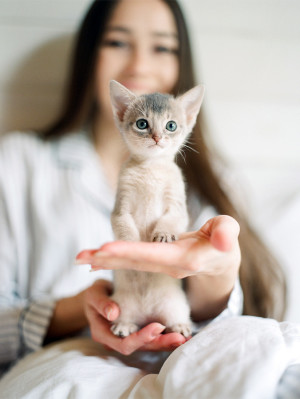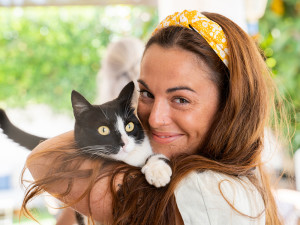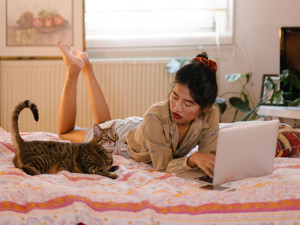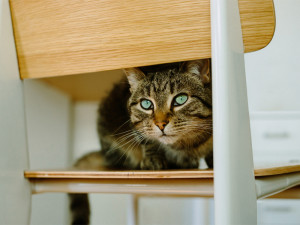Kitten Teething: Do Kittens Lose Their Teeth?
Get those little chompers ready for the kitten tooth fairy.

Share Article
In This Article:
What Is Teething? When Do Kittens Lose Their Baby Teeth? Signs of Kitten Teething How to Help a Teething Kitten Kitten Dental Hygiene Tips
“Kitten teething” refers to the natural process during which a kitten’s baby teeth, also called deciduous teeth, are gradually replaced by their permanent adult teeth. This transition usually starts around three to four months of age and can last until about six months old.
What is teething?
Teething is the process of teeth erupting through the gumline. Kittens are born without teeth (who needs teeth for nursing, anyway?). Kittens go through two courses of teething processes: once when their kitten (deciduous) teeth erupt and again when their adult teeth come in.
As kittens grow, their bodies go through rapid development, which causes some physical and behavioral changes. Kitten parents should be aware of what to expect when their felines have kitten teeth versus cat teeth.

When do kittens lose their baby teeth?
Kittens start to get their first set of teeth around three weeks of age and have a complete set of tiny chompers by eight weeks. Adult teeth start to come in around three months of age and become a full set of permanent teeth by seven months of age. Kittens only have 26 deciduous teeth, but cats have a full set of 30 adult teeth.
Kitten teething age timeline
When kittens start teething, it doesn’t happen all at once. A kitten developing a completely new set of teeth within a day or so would be kind of weird. The process happens so discreetly that most kitten parents don’t even realize when their kitty loses or gains a tooth. Wondering when kittens get adult teeth? Here’s a quick timeline of the teething process.
Birth: Kittens are born without teeth.
Three to four weeks: Deciduous canine and incisor teeth start to erupt.
Five to six weeks: Deciduous premolar teeth come in.
Eight weeks: A kitten should have a full set of 26 baby teeth, made up of 4 canines, 12 incisors, and 10 premolars.
11 to 12 weeks: Adult incisor and canine teeth start to erupt.
16 to 20 weeks: Adult premolars and molars start to erupt.
6 to 7 months: A kitten should have a full set of 30 permanent teeth, made up of 4 canines, 12 incisors, 10 premolars, and four molars. Cats don’t have baby molars, they only have one set with their adult teeth.
Signs of kitten teething
Kitten parents may notice some physical and behavioral changes when their kitten is teething. A quick peek in the mouth can show gaps between teeth along the gumline or inflamed gums. Physical signs can also include finding a stray tooth lying around.
Finding loose teeth is uncommon because kittens typically swallow their baby teeth, but a tooth can come out while a kitten is playing and chewing on toys. Kitten parents may also spot small spots of blood on toys or bedding.
Behavioral changes seen with kitten teething may be more noticeable. Signs of kitten teething may include:
Drooling
Reluctance to eat
Dropping food
Excessive chewing on toys and other objects
Rubbing or pawing at their face
Avoiding being pet on the face or head
Decreased playfulness
How to help a teething kitten
Teething can be uncomfortable for some kittens. Though it’s a natural process, no cat parent wants to see their kitten being cranky or in pain. Here are some things kitten parents can do to ease the process:
Handle with care.
Avoid games that may put extra pressure on a kitten’s teeth and gums, like tug-of-war. Some kitties may become a little head shy if they think you’re going to touch their sore cheeks. Keep cuddles focused on their bodies and be extra gentle when petting their head or face.
Provide chew toys.
It’s normal for kittens to get a sudden urge to chew any and everything while they’re teething. Provide soft chew toys to give them something to sink their teeth into during the process.
Kitten-proof your home.
Much like a kitten who plays with the packaging of a new toy instead of the toy itself, some kittens will seek out alternative objects to chew on even if you give them chew toys. Eliminate access to electric cords, wires, house plants, leather shoes (puppies aren’t the only shoe chewers), and small plastic or rubber objects that can accidentally be swallowed.
Feed soft food.
Chewing on dry kibble can be uncomfortable for a kitten and lead to dropping food or a reluctance to eat. Soften dry kibble with warm water or offer wet food and make sure their food intake is consistent so they get all the nutrients they need to grow and thrive.
Offer a cool cloth.
Kitten parents can help soothe inflamed gums by providing a DIY pacifier. Offer your kitten a cool, damp cloth to gnaw on. Make sure that there are no loose threads that can be accidentally swallowed and keep your fingers out of harm’s way.
Kitten dental hygiene tips
More than 50 percent of cats will have some form of dental disease by age four. That’s why brushing your cat’s teeth is highly encouraged. And the earlier toothbrushing is introduced, the easier it tends to be. However, toothbrushing should be put on hold during kitten teething to avoid causing additional pain and inflammation. Toothbrushing can resume after a kitten has all of their adult teeth — after six or seven months of age.
Toothbrushing may be on hold, but that doesn’t mean that a kitten’s teeth should be ignored. Kittens can develop dental problems while teething. Kitten dental issues can include:
Retained deciduous teeth: Sometimes a kitten’s baby teeth don’t fall out like they should. They stick around as the permanent teeth come in, causing crowding.
Delayed eruption of deciduous teeth: In addition to kitten baby teeth overstaying their welcome, some baby teeth don’t erupt through the gumline. This can happen if the gums are thick and fibrous.
Broken deciduous teeth: Even though baby teeth are meant to fall out eventually, a broken baby tooth should not be ignored because it can lead to pain and infection.
When to see a veterinarian
Your veterinarian will take a peek at your kitten’s teeth during wellness visits, but you should keep an eye out for signs that your kitten is having dental problems. Signs of dental issues in teething kittens include:
Extremely bad breath
Facial swelling
Discolored drool
Refusal to eat
Excessive mouth pain
FAQs (People also ask):
When should I take my new kitten to the vet?
Newly adopted kittens should be evaluated by a vet soon after adoption to get their overall health checked. Kittens typically start vaccines at six weeks of age and have wellness visits scheduled every three to four weeks.
Why is my cat chewing on everything?
Excessive chewing is a common behavior in cats that are teething. Kitten parents can provide teething toys and eliminate access to chewing hazards like electric cords and house plants.
References:

Dr. Alycia Washington, DVM, MS
Alycia Washington is a small-animal emergency veterinarian with over 10 years of experience based in North Carolina. She works as a relief veterinarianopens in new tab and provides services to numerous emergency and specialty hospitals. She also works as a veterinary writer with a focus on educating pet parents.
Related articles
![Kitten sitting on a blanket]()
7 Steps to Keep Your New Kitten Happy and Healthy
With great cuteness comes great responsibility. A vet breaks down everything you need to know when you bring home a new kitten.
![Woman holding her black and white cat.]()
The Ultimate Shopping List for Your New Cat
It’s National Kitten Day! Here are all the new cat essentials you need, recommended by real pet parents.
![Woman bottle feeding kitten.]()
How to Bottle-Feed a Kitten
Starting with the supplies you’ll need.
![Woman using a laptop in bed, looking at her cat]()
What to Expect in the First 48 Hours With Your New Cat
Here’s how to help your rescue kitty feel at home.
![Woman playing with a black kitten.]()
5 Kitten Behavioral Milestones You Should Know
Keep track of all their fun phases with these guidelines.
![Cat sitting on a kitchen chair, looking at the camera]()
How to Cat-Proof Your House
Ten steps for keeping your cat out of trouble.









